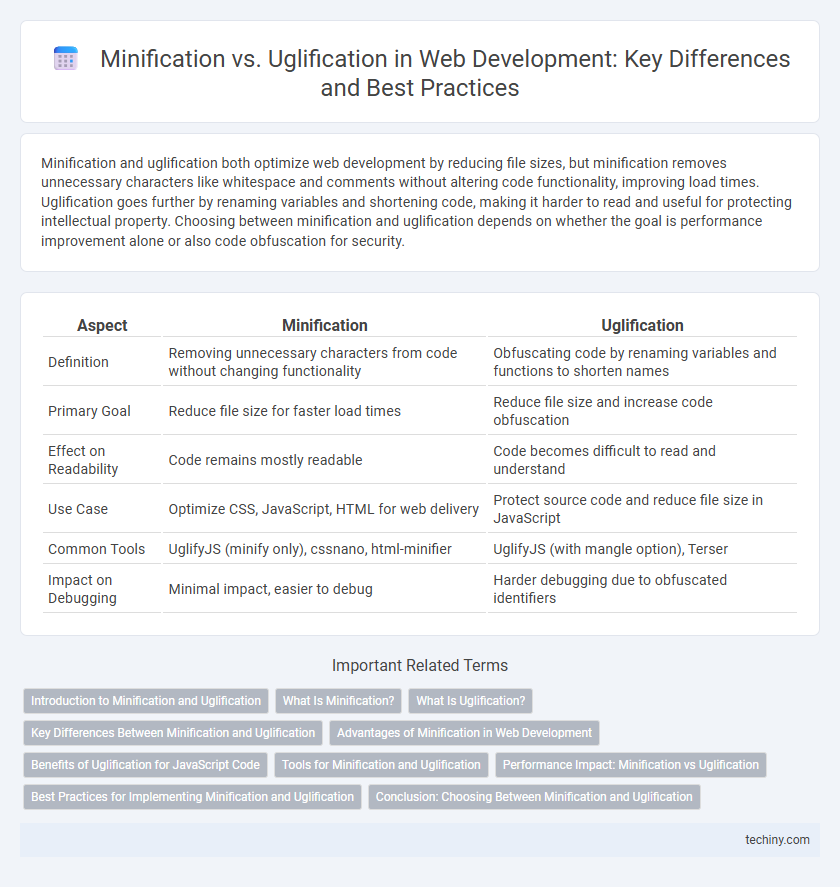Minification and uglification both optimize web development by reducing file sizes, but minification removes unnecessary characters like whitespace and comments without altering code functionality, improving load times. Uglification goes further by renaming variables and shortening code, making it harder to read and useful for protecting intellectual property. Choosing between minification and uglification depends on whether the goal is performance improvement alone or also code obfuscation for security.
Table of Comparison
| Aspect | Minification | Uglification |
|---|---|---|
| Definition | Removing unnecessary characters from code without changing functionality | Obfuscating code by renaming variables and functions to shorten names |
| Primary Goal | Reduce file size for faster load times | Reduce file size and increase code obfuscation |
| Effect on Readability | Code remains mostly readable | Code becomes difficult to read and understand |
| Use Case | Optimize CSS, JavaScript, HTML for web delivery | Protect source code and reduce file size in JavaScript |
| Common Tools | UglifyJS (minify only), cssnano, html-minifier | UglifyJS (with mangle option), Terser |
| Impact on Debugging | Minimal impact, easier to debug | Harder debugging due to obfuscated identifiers |
Introduction to Minification and Uglification
Minification reduces file size by removing unnecessary characters such as whitespace, comments, and line breaks from HTML, CSS, and JavaScript files, enhancing website loading speed and performance. Uglification goes further by renaming variables and functions to shorter names, often making the code less readable but significantly decreasing the payload size. Both techniques are essential in web development workflows to optimize resource delivery and improve user experience.
What Is Minification?
Minification is the process of removing all unnecessary characters from source code without changing its functionality, including white spaces, line breaks, comments, and sometimes shortening variable names. It significantly reduces file size, improving load times and overall website performance. Common tools for minification include UglifyJS, Terser, and CSSNano, which optimize JavaScript and CSS files for faster delivery.
What Is Uglification?
Uglification in web development refers to the process of transforming readable JavaScript code into a compact and obfuscated version that is difficult to understand. This technique not only reduces file size but also helps protect source code from reverse engineering by renaming variables and functions to short or non-meaningful identifiers. Uglification is commonly used alongside minification to optimize performance and enhance code security in production environments.
Key Differences Between Minification and Uglification
Minification reduces file size by removing whitespace, comments, and unnecessary characters without altering functionality, optimizing load times and performance. Uglification transforms code by renaming variables and functions into shorter, less readable forms to obfuscate the source and further decrease file size. While both enhance web performance, minification focuses on compression, whereas uglification balances size reduction with code protection.
Advantages of Minification in Web Development
Minification enhances web development by significantly reducing file sizes of CSS, JavaScript, and HTML, resulting in faster page load times and improved user experience. It helps optimize bandwidth usage and decreases server response times, which contributes to better SEO rankings and lower bounce rates. Unlike uglification, minification maintains code readability to some extent, facilitating easier debugging and future maintenance.
Benefits of Uglification for JavaScript Code
Uglification of JavaScript code enhances performance by reducing file size and obfuscating the source, making it more difficult for attackers to understand the logic and reverse engineer the application. This process improves load times and bandwidth usage, critical factors for user experience and SEO rankings. Uglification also helps protect intellectual property by scrubbing readable function names and variable identifiers, increasing overall code security.
Tools for Minification and Uglification
Tools for minification like Terser and UglifyJS reduce file size by removing whitespace, comments, and unnecessary code, improving website performance and load times. Uglification tools go further by renaming variables and functions to shorter names, which obfuscates the code while optimizing its size. Web developers often use build tools such as Webpack or Gulp integrated with these minification and uglification libraries to automate and streamline the optimization process.
Performance Impact: Minification vs Uglification
Minification reduces file size by removing unnecessary characters such as whitespace and comments, leading to faster loading times and improved web performance. Uglification further transforms code by renaming variables and altering structure to make it less readable, which can enable more aggressive compression and potentially enhance runtime performance. Both techniques improve speed and efficiency, but minification primarily targets payload reduction while uglification optimizes execution by simplifying code complexity for JavaScript engines.
Best Practices for Implementing Minification and Uglification
Implementing minification and uglification in web development requires careful integration within build processes using tools like Webpack, Gulp, or Rollup to ensure JavaScript and CSS files are optimized for faster load times. Best practices include configuring source maps to maintain code debuggability after uglification and minification, applying these techniques selectively to exclude vendor files or third-party libraries to prevent compatibility issues. Consistent testing before deployment helps verify that minified and uglified assets do not break functionality or degrade user experience, ensuring optimized performance and maintainable codebases.
Conclusion: Choosing Between Minification and Uglification
Choosing between minification and uglification depends on the specific goals of the web development project. Minification optimizes file size by removing whitespace and comments, improving load times without altering code readability, while uglification transforms code structure to obscure logic and enhance security alongside size reduction. Developers should prioritize minification for performance and uglification when code protection is a critical concern.
minification vs uglification Infographic

 techiny.com
techiny.com